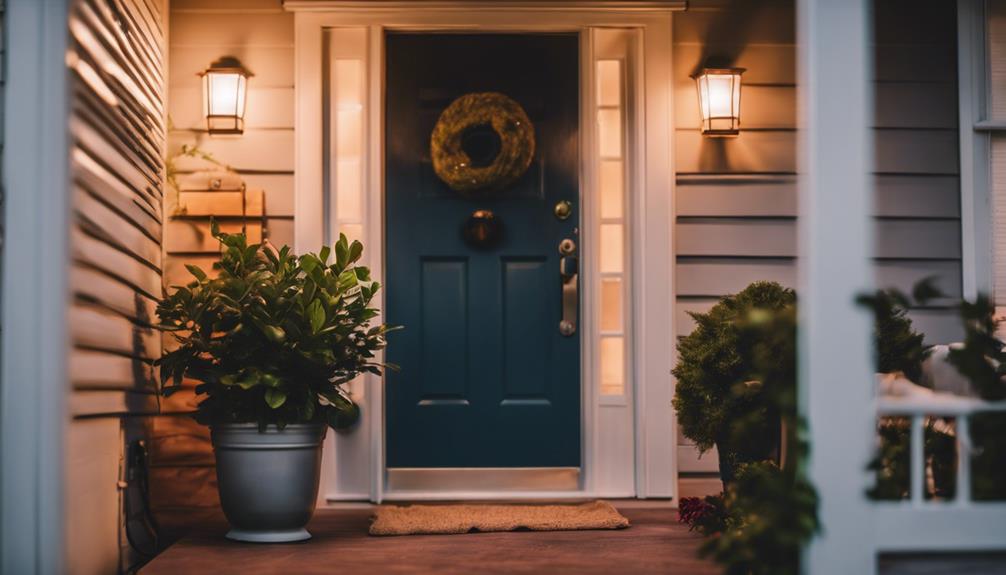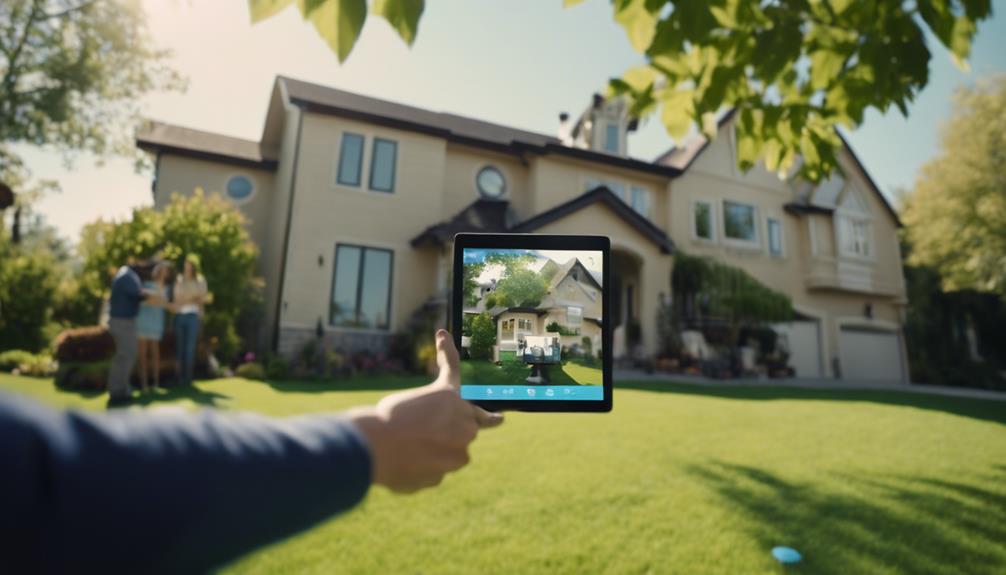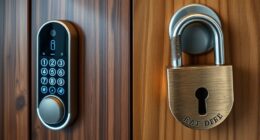Home security systems became increasingly popular in the late 20th century due to the rise in crime rates, prompting people to seek enhanced protection. The demand for safety further intensified after the events of 9/11, causing many individuals to prioritize security measures. The advancements in technology have made these security systems more accessible and user-friendly. With remote monitoring becoming a common feature, homeowners are now able to easily monitor their properties using smartphones and computers. This trend has led to a thriving market, projected to reach $47 billion by 2020. Interested in learning more about the evolution of home security systems and what the future holds? Explore further into the world of home security innovations!
Key Takeaways
- The commercial burglar alarm invention in 1853 marked the initial development of home security systems.
- The rise in crime rates during the 1960s increased consumer demand for improved security solutions.
- Post-9/11 heightened security awareness led to a surge in home security system popularity.
- By 2020, the home security market was projected to reach $47 billion, reflecting growing consumer interest.
Historical Foundations of Home Security
The historical foundations of home security reveal a fascinating evolution, starting with early inventions like the commercial burglar alarm in 1853 and advancing through innovative technologies like Marie Van Brittan Brown's surveillance system in 1966. These developments marked the beginning of the home security market as we understand it today.
The rise of cybersecurity measures has also contributed to the security landscape, emphasizing the need for thorough solutions that extend beyond physical barriers. The first home security systems emerged from the need for improved crime prevention and safety, focusing on security monitoring to protect residential properties.
As crime rates began to climb, consumer interest surged, pushing for better security solutions. The introduction of closed-circuit television (CCTV) during the 1960s provided a new layer of surveillance, influencing homeowners to adopt these technologies. Marie Van Brittan Brown's system, which included features like remote monitoring, set the stage for modern security systems, allowing users to keep an eye on their homes from afar.
Over the following decades, technology evolution continued, leading to more sophisticated devices and integrated systems. By the 2000s, advancements in digital technology and rising concerns about safety resulted in a booming home security market, making security solutions more accessible and appealing for homeowners everywhere.
Invention of Early Security Systems

In 1966, Marie Van Brittan Brown revolutionized home safety by inventing the first home security system, which combined surveillance and monitoring features for enhanced protection. Her innovative design included a motorized video camera, peepholes, a television monitor for live feeds, and an alarm system capable of alerting the police. This groundbreaking approach not only focused on personal safety but also set the stage for what we consider modern home security. The concept of ensuring safety at home has parallels to creating a serene atmosphere in spaces like a modern farmhouse bedroom, where comfort and security are prioritized.
In 1969, Brown received a patent for her security system, marking a significant milestone in the development of residential security technology. Though her invention didn't see commercial production due to unsuccessful efforts to interest manufacturers, it laid the groundwork for future advancements in home security.
Brown's work influenced the evolution of surveillance technologies and contributed to the broader home security industry, paving the way for systems we use today. Her pioneering spirit and innovative design reflect the importance of creating safe environments for families, proving that the quest for personal safety has deep roots in technology.
Your understanding of early security systems can help you appreciate how far we've come in protecting our homes.
Growth of Alarm Monitoring Services

Alarm monitoring services have greatly expanded over the years, evolving from basic systems to advanced technologies that offer homeowners peace of mind and immediate response capabilities.
In the late 19th century, Edwin Holmes pioneered these services, but it wasn't until the 1960s that they truly gained traction. With advancements in technology, central monitoring offices became established, allowing for quicker response times to alarms.
The increasing demand for security has also led to the rise of professional home cleaning services, ensuring that homes not only remain secure but also well-maintained.
By 2020, the home security market was projected to reach $47 billion, with alarm monitoring services driving significant market growth. Companies like ADT emerged as leaders, boasting over 6 million subscribers, highlighting the increased consumer awareness of security needs.
The shift to cellular and internet-based monitoring in the 2000s transformed alarm monitoring services, providing you with real-time alerts and remote access to your system.
This evolution has made it easier for you to stay connected to your home security, no matter where you are.
As consumer reliance on these services continues to grow, alarm monitoring remains an essential component of modern home security, addressing your ever-changing security needs effectively.
Advances in Surveillance Technology

Advancing surveillance technology has transformed how you monitor and protect your home, offering unprecedented capabilities and convenience.
From the early days of closed-circuit television (CCTV) systems, which were first used in the U.S. for security monitoring in the late 1940s, to today's sophisticated solutions, the evolution of video surveillance has been remarkable.
The introduction of Internet Protocol (IP) cameras in the 1990s revolutionized home security by enabling remote access, allowing you to check in on your property from anywhere. As keyword clustering becomes more important for effective content strategies, leveraging these technologies can help homeowners better understand their needs and enhance their security measures.
With technological advancements, digital security cameras have improved image quality and functionality, making it easier to identify intruders.
Modern surveillance systems integrate various features, including motion detection, night vision, and cloud storage, ensuring you have thorough security monitoring.
These advancements not only enhance your home security but also provide peace of mind, knowing you can monitor your property in real time.
As these technologies continue to evolve, you can expect even greater convenience and effectiveness in protecting your home.
Embracing these advancements means investing in a safer, more secure environment for you and your loved ones.
Rise of Wireless Security Solutions

You've likely noticed how increased internet connectivity has made wireless security solutions more appealing.
With cost-effective installation options, setting up a security system has never been easier or more accessible.
Plus, enhanced user control lets you monitor and manage your home security from anywhere, putting peace of mind right at your fingertips.
Increased Internet Connectivity
Wireless security solutions have surged in popularity as internet connectivity has improved, making home security more accessible and efficient for everyone.
With the evolution of technology, you can now enjoy robust security systems that utilize wireless components. The change started in the 1990s, when advancements in cellular monitoring and wireless sensors made installation easier and less costly. This alteration paved the way for networked cameras in 1996, which enhanced data transmission and allowed for remote access. The integration of AI-driven solutions in security systems has further increased their effectiveness against emerging threats, providing homeowners with peace of mind.
By the 2000s, hardwired systems saw a decline as homeowners preferred the convenience of cellular and internet-monitored options. Smart home technology further revolutionized security, connecting devices like smart locks and cameras to your home network. This integration means you can manage your security remotely, using apps and web browsers.
Interactive services emerged, giving you real-time alerts and live footage from your monitoring systems. This level of access empowers you to stay in control of your home security, no matter where you are.
With these advancements, home security has transformed into a more dynamic and user-friendly experience, ensuring your property is protected with the latest technology.
Cost-Effective Installation Options
As technology has evolved, homeowners have embraced cost-effective installation options that simplify setting up security systems without needing professional help.
The rise of wireless security solutions has dramatically lowered installation costs by eliminating the need for extensive wiring. This shift, particularly with wireless sensors, has fueled the DIY home security market, which was valued at approximately $1.5 billion by 2020.
Additionally, advancements in garage door openers have contributed to enhancing home security, allowing for remote access and monitoring.
The introduction of networked cameras in 1996 marked a significant change, offering greater flexibility and ease of installation for homeowners. These modern solutions integrate seamlessly with smart home technologies, enhancing the affordability and accessibility of security systems.
You can now monitor your home remotely through mobile devices, making security more convenient than ever.
As installation costs continue to decrease and user-friendly options become more prevalent, consumer adoption of these systems has surged.
With the home security market projected to reach $47 billion by 2020, it's clear that the popularity of DIY security solutions is on the rise.
Embracing these innovations not only protects your home but also saves you money on installation and maintenance.
Enhanced User Control
Homeowners now enjoy enhanced control over their security systems, thanks to the rise of wireless solutions that simplify remote access and monitoring. This shift began in the 1990s, when wireless security solutions allowed for easier installation and reduced costs compared to traditional hardwired systems.
By the early 2000s, interactive services took this a step further, enabling you to control your home security from anywhere using apps and web browsers. The evolution of AI security in cyber defense has also contributed to greater safety, as automated responses to threats guarantee that homeowners can act swiftly in emergencies.
The introduction of cellular monitoring increased the reliability of communication between your security systems and monitoring services, providing prompt responses to alerts. With the integration of smart home technologies, features like automated lighting and remote access became standard, empowering you to manage your home security more effectively.
Additionally, the shift to networked cameras in 1996 revolutionized surveillance. Now, you can stream live footage directly to your devices, allowing for real-time monitoring of your property. This enhanced user control means you're not just a passive observer; you can actively engage with your security systems, guaranteeing peace of mind and a safer home environment.
The Impact of Smart Home Technology

Smart home technology has revolutionized security systems, enabling you to monitor and control your home remotely with devices like smart locks, cameras, and motion sensors.
With the integration of wireless sensors, home security systems have become more accessible and affordable, considerably reducing installation costs. You can now enjoy features such as real-time alerts, which keep you informed about potential threats, and automated lighting that enhances your home automation experience.
Additionally, professional email etiquette can play a role in communicating security concerns effectively, ensuring that all parties involved are informed and prepared.
As you leverage remote monitoring capabilities, you gain greater control over your home's safety, whether you're at home or away. Smart security cameras allow you to check in on your property anytime, providing peace of mind.
However, it's crucial to remain aware of privacy concerns that come with these technologies. The more connected your devices are, the more important it's to secure your personal data against potential hacking incidents.
In this rapidly evolving landscape, smart home technology not only enhances your security but also transforms the way you interact with your living space, making it a critical component of modern home safety.
Embracing these advancements can ultimately lead to a safer, more secure environment for you and your family.
Crime Rates and Security Trends

Rising crime rates in various regions have prompted many to reconsider their home security measures, driving increased interest in advanced security solutions. With an alarming number of burglaries reported annually, homeowners are more aware of their vulnerability and the need for reliable home security systems.
Although property crime rates have declined, the FBI reported 1.7 million burglaries in 2014, highlighting ongoing security concerns.
To help you understand the current trends, consider these key points:
- Increased consumer interest: Homeowners are actively seeking out security solutions to protect their properties.
- Technology advancements: Modern security systems now offer features like remote monitoring, making personal security more accessible.
- Low adoption rates: Only 17% of U.S. homes have security systems, suggesting significant potential for growth in this market.
As crime trends evolve, staying informed about security options is essential for safeguarding your home and ensuring peace of mind.
Popularity Surge Post-9/11

After 9/11, you likely noticed a significant shift in how people viewed home security.
With rising security awareness and the introduction of advanced technologies, many homeowners turned to alarm systems and surveillance cameras to feel safer.
This growing demand for protection led to an explosion of DIY security options that changed the market landscape.
Increased Security Awareness
In the wake of 9/11, many homeowners felt a pressing need to bolster their home security, leading to a significant increase in the popularity of security systems. The tragic events heightened security concerns, making it clear that safety at home was more critical than ever. Increased media coverage of crime and terrorism spurred public awareness, prompting homeowners to take proactive steps to protect their families and belongings.
Key factors influencing this surge included:
- Fear of burglaries: Homeowners wanted to deter break-ins and protect their valuables.
- Advent of technologies: Internet-connected cameras and smart home devices made monitoring your home easier.
- Shift in consumer attitudes: The events of September 11 altered how people viewed safety, making security systems a must-have.
As a result, home security systems became a common consideration, with many homeowners investing in solutions to address their heightened security concerns.
Technological Advancements Accelerated
Technological advancements played an essential role in skyrocketing the popularity of home security systems after 9/11, as homeowners sought innovative ways to protect their families and property.
In the early 2000s, the tragic events of September 11 heightened safety concerns, driving many to invest in enhanced security measures. High-speed internet access became widely available, making it easier to install and utilize remote monitoring capabilities. This new access greatly boosted consumer interest in home security solutions.
The adoption of surveillance cameras rapidly increased during this time, primarily due to their effectiveness in burglary deterrence and real-time monitoring features. Homeowners began to prioritize systems that allowed them to monitor their properties directly from their smartphones or computers.
The shift towards smart home technologies, including internet-connected security, transformed the market, making security more accessible and customizable than ever before.
Modern Home Security Innovations

Modern home security innovations are transforming how you protect your home, making it easier and more efficient than ever before. With advancements in smart home technologies, you can now enjoy a thorough home security camera system that includes features like motion sensors, real-time alerts, and remote monitoring capabilities.
Here are some key innovations that enhance your home security:
- Cloud-connected security cameras: Store and access video footage easily without bulky equipment.
- Interactive services: Control your security system through mobile apps and web browsers, adding convenience to your daily life.
- Wired or wireless options: Choose a setup that fits your needs and budget, lowering installation costs.
These innovations not only provide enhanced protection but also allow you to monitor your home from anywhere.
As the industry continues to grow, you'll find that modern security solutions are becoming an essential part of home safety. Embracing these technologies means you're investing in peace of mind and a secure environment for you and your loved ones.
Future of Home Security Systems

As smart home technologies evolve, the future of home security systems looks promising, with innovations set to enhance safety and convenience for homeowners.
You can expect a dramatic rise in the use of integrated security systems that combine various features for a more thorough approach to home security. Wireless monitoring will continue to grow, making it easier for you to install and manage your security systems without complicated wiring.
With the increasing consumer demand for safer homes, security cameras and smart locks are becoming standard components of your everyday security setup. These smart home devices offer real-time alerts and easy remote monitoring, ensuring you're always connected to your home, no matter where you are.
Moreover, the integration of artificial intelligence will revolutionize how these systems function, enabling smarter threat detection and response. Interconnected security solutions will allow all your devices to work together seamlessly, creating a cohesive protective network.
As these advancements unfold, you can feel more secure and empowered in your home, knowing that cutting-edge technology is working in your favor.
Frequently Asked Questions
What Year Was the First Home Security System?
The first home security system was patented in 1969 by Marie Van Brittan Brown. It featured a motorized video camera linked to a monitor, allowing homeowners to see and communicate with visitors at their door.
What Percentage of American Homes Have Security Systems?
Only about 17% of American homes have security systems installed. This low percentage highlights the importance of raising awareness about home security options, especially given the increasing crime rates and potential losses from burglaries.
What Was the Security System in the 1990s?
In the 1990s, you saw a shift to wireless sensors, cellular monitoring, and networked cameras. These advancements made security systems easier to install and manage, paving the way for enhanced home protection and automation.
What Were the Home Security Systems in the 1970s?
In the 1970s, you'd find basic alarm systems with simple sensors and control panels. Many homeowners opted for burglar alarms and monitored services, responding to rising crime rates with proactive security measures for peace of mind.
What Contributed to the Popularity of Home Security Systems?
The history of home security systems has contributed to their popularity today. As crime rates have risen, people have become increasingly concerned with protecting their homes and families. The advancement of technology has made home security systems more affordable and accessible, leading to their widespread use in modern homes.
Conclusion
In a world where crime lurks behind every corner and home invasions are just a heartbeat away, you can't afford to ignore home security systems.
They've evolved from basic alarms to high-tech fortresses that could make Fort Knox jealous!
With crime rates soaring and technology advancing at lightning speed, investing in a security system isn't just smart; it's essential.
So, don't wait for a wake-up call—arm your castle and sleep like a baby, knowing you're protected!









